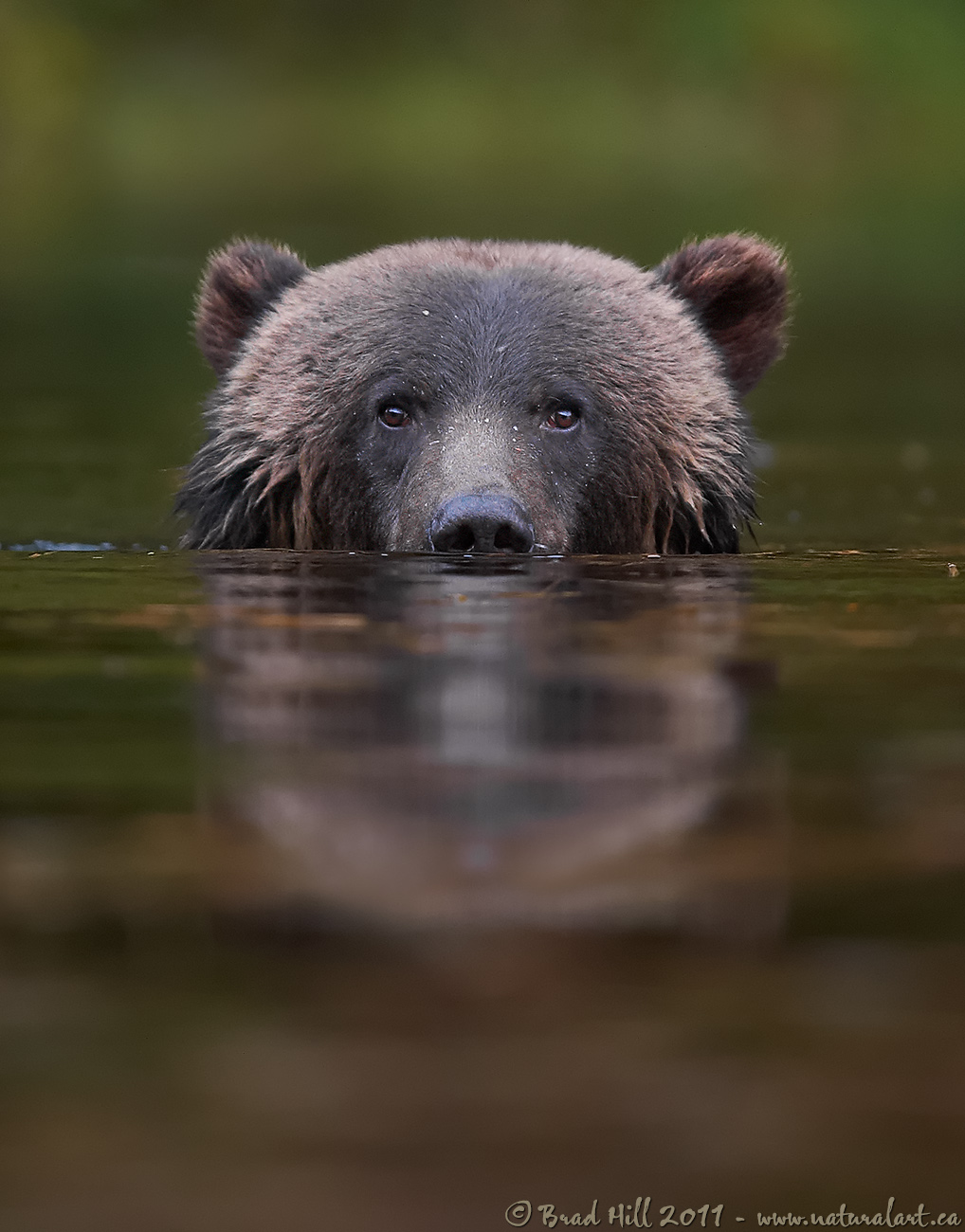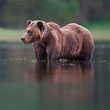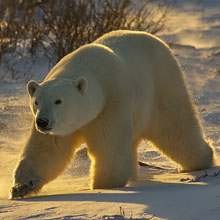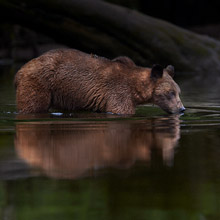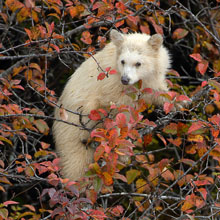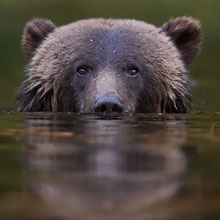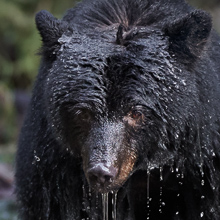Availability: Undetermined - Enquiries?
In the Field
Eye-to-Eye! Inlet in Great Bear Rainforest (on northern BC Coast), BC, Canada. October 2, 2011.
This is an image that lived in my head for a long time before I finally got a chance to turn it into photographic reality. Sometimes the simplest images - at least graphically - are the toughest to capture!
I'm known for being picky about foregrounds. But in a way this is a bit of bad rap - what I'm really picky about is the use of out-of-focus (or OOF) zones. In most cases I have a bit of a knee-jerk reaction against images that have multiple OOF zones in them. Which, given the laws of optics, means an OOF zone in the foreground, a focused zone somewhere in the middle of an image, and an OOF zone in the background. My primary reason for disliking this is simply that it's SO foreign to the way our unaided eyes work. Our brain gives emphasis/attention to what our eyes are focused on, but it doesn't throw everything else out of focus. I can live with (and quite like) OOF backgrounds as a rough "proxy" for the ability of our brain to discard or filter out things in our visual field that we aren't paying attention to. But...when an image contains 3 distinct OOF bands that stretch from edge-to-edge it just looks too unnatural (or "contrived") for my personal taste. This is especially true when the foreground contains irregular objects (like globular rocks or bushes) the really draw one's eye (often in an effort to figure out what the heck the lump is).
So what about this image? Well, although others have reacted very well to this shot, to be perfectly honest I'm not 100% happy with it. And that's mainly because of the brown tones in the lower foreground (which, if memory serves me correctly, are reflections of logs on the shoreline behind the bear) - I'd prefer if all the foreground (except the bear's reflection) was the same colour of green as that in the background so that the illusion of their being only one OOF zone (and one attention-grabbing in-focus zone) was a little more complete. But I suppose I'll live with this image until I happen to stumble upon another grizzly submerged up to its nose and intently staring at me! ;-)
ADDITIONAL NOTES:
1. This image - in all resolutions - is protected by copyright. I'm fine with personal uses of them (including use as desktop backgrounds or screensavers on your own computer), but unauthorized commercial use of the image is prohibited by law. Thanks in advance for respecting my copyright!
2. This image was captured during one of my autumn "Into the Great Bear Rainforest" photo tours in 2011. Each year I offer trips into two different parts of the Great Bear Rainforest as well as one to photograph marine mammals and oceanscapes near the northern tip of Vancouver Island. And, in selected years, I also offer photo tours to additional locations to capture other highly sought-after subjects, such as various boreal owl species, fishing grizzlies, and more. Details about these trips can be found on the Photo Tours page of this website.
3. Like all wildlife photographs on this website, this image was captured following the strict ethical guidelines described in The Wildlife FIRST! Principles of Photographer Conduct. I encourage all wildlife photographers to always put the welfare of their subjects above the value of their photographs.
Behind the Camera
Eye-to-Eye! Inlet in Great Bear Rainforest (on northern BC Coast), BC, Canada. October 2, 2011.
Digital Capture; Compressed RAW (NEF) 14-bit format; ISO 2500.
Nikon D3s with Nikkor 400mm f2.8 VRII lens - handheld. VR on and in "Normal" mode.
1/250s @ f2.8; -0.33 stop compensation from matrix-metered exposure setting.
At the Computer
Eye-to-Eye! Inlet in Great Bear Rainforest (on northern BC Coast), BC, Canada. October 2, 2011.
RAW Conversion to 16-bit TIFF, including first-pass/capture sharpening using Phase One's Capture One Pro 6. Two exposure variants covering a 0.5 stop total range.
Further digital corrections on 16-bit TIFF file using Adobe's Photoshop CS5 and Light Craft's LightZone. Photoshop adjustments including compositing (layering and masking) the exposure variants, selective colour desaturation, and sharpening for web output. Final contrast/tone tweaking - particularly to mid-tones - performed with LightZone using the tonemapper/re-light tool.
Conservation
Eye-to-Eye! Inlet in Great Bear Rainforest (on northern BC Coast), BC, Canada. October 2, 2011.
Ten percent of the revenue generated by this image will be donated to Raincoast*.
Species Status in Canada**: Special Concern (May 2002).
While Grizzly Bears (Ursus arctos) are not technically listed as "Endangered" in Canada, they have been extirpated from most of their historical range. Grizzly Bears are far more sensitive to intrusion/disturbance in their habitat than are Black Bears and are being increasingly forced into marginal habitat by human encroachment. The Great Bear Rainforest along the central and northern coast of British Columbia is one of the last strongholds of the Grizzly Bear in Canada, and even this population is coming under increasing pressure.
On December 18, 2017 the government of British Columbia banned grizzly hunting across the entire province. This major conservation victory came after decades of tireless work by many dedicated conservationists and ecologists and, most importantly, it reflects the opinion of the vast majority of British Columbians. And, it means that AT LEAST while the current government remains in power grizzlies are finally "safe" in British Columbia.
Now that we've at least temporarily won the battle to save grizzlies in BC, it's time to re-focus our efforts toward protecting ALL of BC's carnivores, including Gray Wolves, Black Bears, Cougars, Wolverines, and more! Simply put, there are no ecological, economic, or ethical arguments supporting the trophy hunting of carnivores.
In a great first step towards ending the hunting of carnivores throughout BC the Raincoast Conservation Foundation has developed a program designed to protect ALL carnivores within the Great Bear Rainforest. Details about this program can be found on this page on Raincoast's website. Check it out and, better yet, make a donation to help Raincoast purchase the remaining commercial hunting tenures in the Great Bear!
*The Raincoast Conservation Society (and Foundation) is an effective and efficient organization that has been fighting for protection of this unique habitat. If you are looking for a meaningful way to contribute to the conservation of this amazing ecosystem, Raincoast will provide maximal "bang" for your conservation dollars.
**as determined by COSEWIC: The Committee on the Status of Endangered Wildlife in Canada












